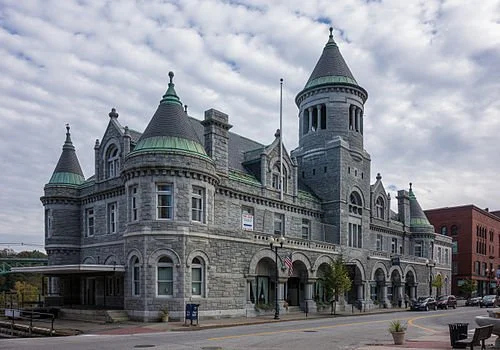
Scott Klinger: Trump’s postmaster general continues to wreak havoc as Christmas nears
The old post office in Augusta, Maine, a notable example of Romanesque architecture
Via OtherWords.org
HARPSWELL, Maine
Last year’s holiday season was not exactly a merry one for the U.S. Postal Service. In the lead-up to Christmas, overwhelmed postal workers had to leave gifts sitting in sorting facilities for weeks. They delivered just 38 percent of greeting cards and other nonlocal first-class mail on time.
What should we expect this year?
USPS leaders claim they are ready for the rush. But customers have reason to worry about slower — and more expensive — service.
The service is aiming to hire 40,000 seasonal workers for the holidays. But that’s 10,000 less than last year — and given broader pandemic staffing shortages, recruitment and retention for these demanding jobs will not be easy. While the e-commerce surge that strained the system last year has declined somewhat, postal workers are still delivering many more packages than before the crisis.
And COVID-19 is not the only reason for concern. In fact, the root causes of our country’s postal problems are inaction by Congress and misguided action by USPS leadership.
For more than a decade, Congress has failed to fix a policy mistake that requires the Postal Service to set aside money to prefund retiree health care more than 50 years in advance. This burden, which applies to no other federal agency or private corporation, accounts for 84 percent of USPS reported losses from 2007 to 2020. If Congress had made the same demand of America’s strongest businesses, many would be bankrupt.
A bill to repeal this pre-funding mandate and put USPS on a stronger financial footing enjoys strong bipartisan support. But House and Senate leaders have not brought up this bill, the Postal Reform Act, for a vote.
In the meantime, U.S. Postmaster General Louis DeJoy, a Trump campaign contributor, is using the agency’s artificially large losses to justify jacking up prices and slowing deliveries.
If you’re planning to send holiday cards a significant distance this season, say from Pittsburgh to Boise, the USPS delivery window is now five days instead of three. These reduced service standards affect about 40 percent of First Class mail.
As part of a 10-year plan, DeJoy is also slowing delivery by 1 to 2 days for about a third of First Class packages. These are small parcels often used to ship highly time-sensitive medications, as well as other lightweight e-commerce purchases.
A big cause of the slowdown: DeJoy’s plan to cut costs by shifting long-distance deliveries from planes to trucks. This is a rollback of the introduction of airmail more than 100 years ago — one of many postal innovations that strengthened the broader U.S. economy.
For worse service, we’ll have to pay more.
In August, USPS raised rates for First Class mail by 6.8 percent and for package services by 8.8 percent. A holiday surcharge will raise delivery costs by as much as $5 per package through December 26. In January, rates for popular flat-rate boxes and envelopes will increase by as much as $1.10.
Next up on DeJoy’s plan: reduced hours at some post offices and the closure of others.
USPS officials argue these draconian moves will boost profits. But even the regulator that oversees the agency has criticized the underlying financial analysis.
Instead, DeJoy’s 10-year plan will more likely drive customers away. That, in turn, will lead to fewer of the good postal jobs that have been a critical path to the middle class, particularly for Black families.
Unless Washington lawmakers lift the financial burden they imposed on USPS, DeJoy will be empowered to keep up his self-defeating cost-cutting spree.
Postal workers and their customers have struggled to overcome the extreme challenges of the pandemic. Now it’s time for Congress to deliver by passing the Postal Reform Act and urging USPS leaders to focus on innovations to better serve all Americans for generations to come
Scott Klinger, who lives in Harpswell, is senior equitable development specialist at Jobs With Justice.
On Ragged Island, Harpswell, Maine, circa 1920
Scott Klinger: Tax breaks for business slam public schools
As fall approaches, millions of moms and dads are scrambling to prepare for the first day of school, excited to support their children’s success.
But are schools ready to receive our kids and foster that success? Increasingly, the answer is no.
In at least 18 states, local government funding levels are declining, according to an analysis by the Center for Budget and Policy Priorities. And as a result, many schools will open with fewer teachers than last year, among other detrimental losses.
As lawmakers throw up their hands and say, “sorry, there’s just not enough money,” we must ask: Where has all the money gone?
State and local governments give away at least $70 billion a year to business subsidies, most of it in foregone tax revenue. Local property taxes are the most significant tax most corporations pay. In most communities, they’re also the backbone of local school finance.
So when subsidies slash corporate property taxes, our schools often get hurt the most.
In Chicago, for example, we already have a glimpse into the unsavory relationship between tax subsidies and school finance. Last year, one subsidy program alone cost public services $461 million. Meanwhile, the city’s schools are facing a budget that is $140 million less than they had last year.
When cities line the pockets of powerful interests with subsidies while short-changing children, they harm everyone — including businesses that depend on a well-educated work force.
Unlike Chicago, in most cities it’s difficult to calculate exactly how much state and local tax subsidies drain from a given school district. But that’s about to change.
Starting next year, the Governmental Accounting Standards Board will require more than 50,000 government bodies to report how much tax revenue they’ve lost to economic development tax breaks given to developers and corporations.
Though school districts, library districts, and other special purpose districts seldom have a role in awarding these subsidies, they too will be required to report how much revenue they’ve lost lost—even as a result of tax breaks handed out by other governmental bodies.
This new data will also shine a light on inequities in education, allowing new critical examination of whether tax breaks that fill corporate coffers come disproportionately at the expense of the most disadvantaged school districts.
This way, we can say no to deals that pad the profits of the already wealthy at the cost of denying opportunity to those looking to get a foot on the first rung of the economic ladder.
Some states are already following the logic of this new common sense standard. In a 2011 budget deal, California decided to phase out an expensive subsidy granted by redevelopment agencies, and as a result, paved the way for local property tax revenues to rise by 10-15 percent in coming years. These added revenues will allow cities and towns throughout California to increase funding for local priorities—including schools.
Soon, we’ll all have a much better idea about where the funding for schools throughout the nation has gone. Parents and teachers clamoring for smaller class sizes and more support services will have the data to back their demands.
And taxpayers will be able to debate whether costly, long-term tax breaks that often go to the most prosperous businesses in town have been worth the cost of struggling schools.
As we look ahead to the new school year, it’s time to hold our governments and schools accountable to meet student needs. The data is coming soon that will help us get there.
Scott Klinger is the GASB 77 Activation Coordinator at Good Jobs First. To learn more about the GASB 77 disclosures coming next year, visit www.goodjobsfirst.org/gasb. Distributed by OtherWords.


